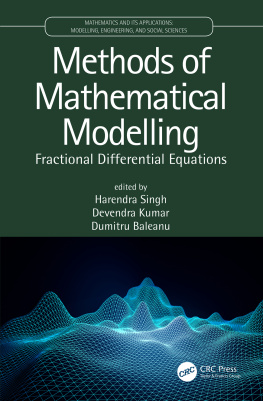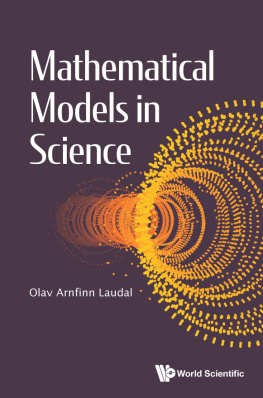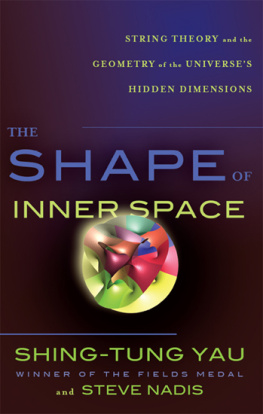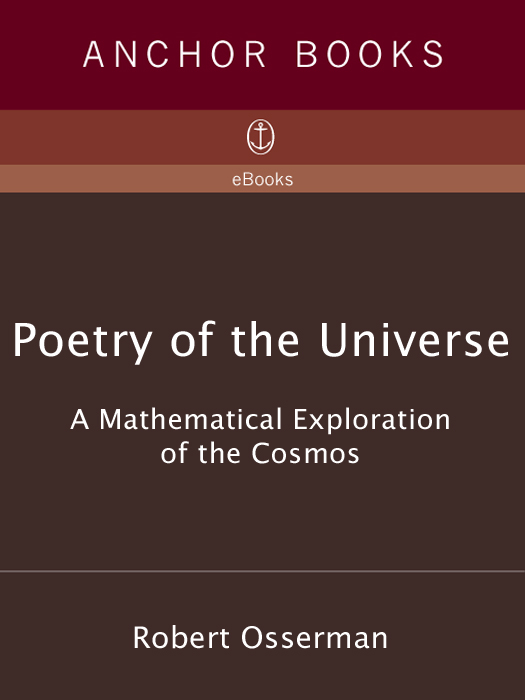P RAISE FOR R OBERT O SSERMANS
Poetry of the Universe
Wow. Poetry of the Universe manages to pack a lot in a masterful job.
Los Angeles Times
Though the light of science and the light of art are inseparable and the same, their bearers speak different languages and only the best among them understand that they are engaged in the same enterprise. In Poetry of the Universe, Robert Osserman enriches the tradition of unifying the two disciplines by speaking his own language with extraordinary clarity and accessibility, by burning off the clouds.
M ARK H ELPRIN
Thoroughly delightful. It shows how mathematics and our understanding of the universe evolve together. Ossermans lucid explanations and passion make this book daring in scope and yet richly personal.
G EORGE F. S MOOT , astrophysicist,
University of California at Berkeley,
author of Wrinkles in Time
An elegant introduction to many of the beauties of mathematics and their relationship to the physical world.
R OGER P ENROSE , author of The Emperors New Mind
and Rouse Ball Professor of Mathematics, Oxford University
Elegant the atmosphere is leisurely and there is much more emphasis on the integration of the history of ideas in mathematics with the surrounding culture than on simplified expositions.
Nature
Poetry of the Universe sets forth with admirable clarity the history of the mathematical conquest of the world around us.
D IANE M IDDLEBROOK , author of Anne Sexton
A celebration of the genius of man at every level it should be required [reading] by anyone who wishes to have a greater understanding of mankind, our genius and our possibilities.
South Bend Tribune
[Poetry of the Universe] will be appreciated by all who read it.
Capital Times
A wonderful book. It shows the extent to which the universe becomes understandable through the medium of mathematics.
P HILIP J. D AVIS , co-author of the American Book
Award-winning The Mathematical Experience
Essential reading for those educated in the liberal and fine arts who have never had the opportunity to appreciate the beauty of mathematics and physics.
Library Journal
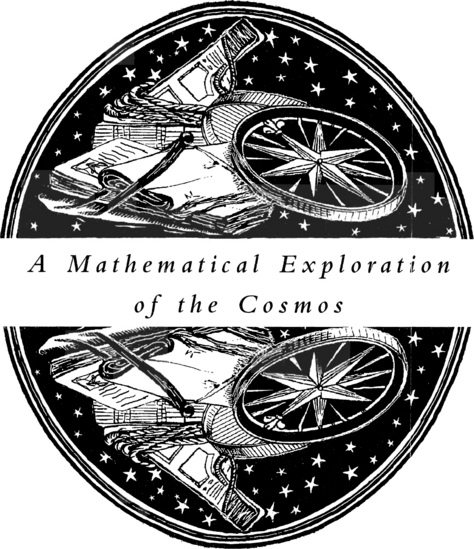
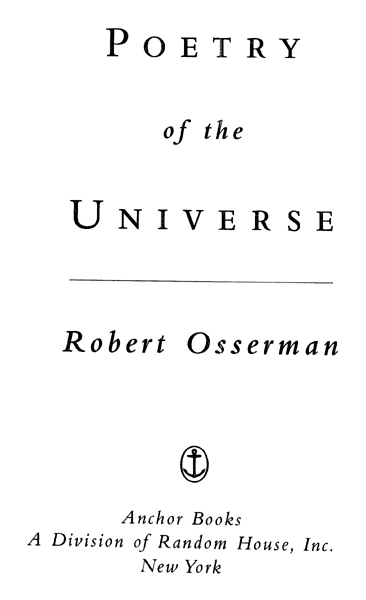
FIRST ANCHOR BOOKS TRADE PAPERBACK EDITION, FEBRUARY 1996
Copyright1995 by Robert Osserman
All rights reserved under International and Pan-American Copyright Conventions. Published in the United States by Anchor Books, a division of Random House, Inc., New York, and simultaneously in Canada by Random House of Canada Limited, Toronto. Originally published in hardcover in the United States by Anchor Books in 1995.
A NCHOR B OOKS and colophon are registered trademarks of Random House, Inc.
The Library of Congress has cataloged the Anchor hardcover edition of this work as follows:
Osserman, Robert.
Poetry of the universe : a mathematical exploration of the cosmos /
Robert Osserman.
p. cm.
1. MathematicsPopular works. I. Title.
QA93.O87 1995
530.15dc20 94-27971
eISBN: 978-0-307-79058-3
WWW.ANCHORBOOKS.COM
v3.1
D EDICATION
T o my wife, Janet Adelman, for moral, spiritual, nutritional, and syntactical sustenance during the long gestation of this book, and to my sons, Brian and Stephen, for their active interest, assistance, and understanding.
C ONTENTS
E UCLID ALONE HAS LOOKED ON B EAUTY BARE .
Edna St. Vincent Millay
P URE MATHEMATICS IS, IN ITS WAY ,
THE POETRY OF LOGICAL IDEAS .
Albert Einstein
W E HAVE HEARD MUCH ABOUT THE POETRY OF MATHEMATICS, BUT VERY LITTLE OF IT HAS YET BEEN SUNG T HE MOST DISTINCT AND BEAUTIFUL STATEMENT OF ANY TRUTH MUST TAKE AT LAST THE MATHEMATICAL FORM .
Henry David Thoreau
P REFACE

O n April 24, 1992, newspapers around the world reported an event that was hailed as one of the major discoveries of the centurywhat some would call the missing link and the Holy Grail of cosmology. The discovery was presented in the form of a picture that was in essence a snapshot of the universe at a dramatic moment in its evolutionthe moment that space began. Before the time of the picture, there was only a conglomeration of elementary particles in a state of continual creation and annihilation. Then electrons and protons combined to form atoms of matter. For the first time there was space between the atoms, allowing light and other forms of radiation to travel freely. The snapshot depicts the pattern of rays that have reached us after traveling through space from that moment to the present. What was electrifying to scientists who had been studying those raysthe so-called cosmic microwave background radiationwas that there was a pattern in the picture. After decades of frustration at trying to detect even a ripple of variation in the apparently featureless sea of uniform background radiation, they were now successful in finding a possible link between the undifferentiated primeval soup predicted by the big bang theory of the creation of the universe and the later evolution into the highly differentiated stars and galaxies of the universe as we know it today. But reporters attempting to explain the precise nature of the picture were faced with at least one insurmountable obstacle: neither they nor their readers were prepared for the paradoxical nature of an image that depicts simultaneously a view outward in all directions from the earth and inward in all directions toward the big bang.
The big discovery of 1992 recalls in both obvious and more subtle ways the discovery of America just five hundred years earlier. If we look further back to the year 1000 A.D. , Europeans generally pictured the earth as flat. It took great efforts of the imagination over the subsequent centuries to grapple with and understand the implications of a spherical earth, and to appreciate why people at the opposite side who were hanging upside down by their heels did not either fall off or suffer from perpetual headaches. The voyages of Columbus and those following in his wake gave a sense of reality and concreteness to the theoretical view of a round earth that had gradually been established before his time.
Now, as we approach the year 2000, there are few people left who believe in a flat earth, but most of the worlds population continues to think in terms of a flat universe. Just as everyday experience led us to think of the earth as flat or planar rather than curved, so does our perception of the world around us lead us to view space as flat or euclidean. It requires as great an effort of the imagination in the twentieth century to conceive of curved space as it did a thousand years ago to conceive of the earth as a gigantic ball somehow suspended or floating freely in an even more gigantic expanse of space. Nevertheless, the evidence is overwhelming that space is indeed curved, and only in that context can the cosmic microwave photograph of 1992 be fully understood.


